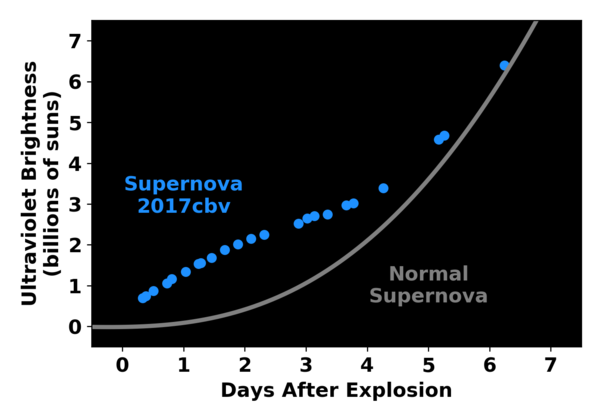Stars, like people, often hang out with their neighbors. Though our Sun appears to be a bit of a loner, with no obvious companions nearby, scientists have estimated that around half of all star systems in the Milky Way are comprised of at least two stars, including the closest system to our own, Alpha Centauri, which contains three.But as fun as it is to have friends in life, kicking it with other stars also comes with major risks, as demonstrated by new research published in The Astrophysical Journal Letters. Led by Griffin Hosseinzadeh, an astrophysics PhD student at the University of California, Santa Barbara, the study reveals that an exploding star called SN (supernova) 2017cbv straight-up bodyslammed its companion star. While we've all had self-destructive friends, this is truly a whole other level."The universe is crazier than science fiction authors have dared to imagine," said Andy Howell, a staff scientist at Las Cumbres Observatory and Hosseinzadeh's PhD adviser, in a statement. "Supernovae can wreck nearby stars, too, releasing unbelievable amounts of energy in the process."SN 2017cbv was first spotted on March 10, 2017, by University of Texas astronomer David Sand, who co-authored the new research with Hosseinzadeh. It was captured by the DLT40 survey, which uses the Panchromatic Robotic Optical Monitoring and Polarimetry Telescope (PROMPT) in Chile to search for supernovae within 40 megaparsecs, or 120 million light years, of Earth. The tip-off that the supernova had engulfed its neighboring friend was an "optical blue bump" observed in the exploding star's light curve, which is a measurement of the intensity of an object's light over time. This suggests that the exploding star was shocked into emitting high-energy blue and ultraviolet light when it impacted its neighbor.Based on these observations, the team was able to estimate that the companion star's radius was about 20 times longer than that of our Sun. The white dwarf companion was likely pilfering stellar material off its enormous star friend, which eventually sparked the explosion. These events are known as Type Ia supernovae, and they only occur in binary systems with at least one white dwarf."We have a very well-sampled early light curve that clearly shows a bump compared to normal Type Ia supernovae, unlike previous studies [in 2015 and 2016] that just had one data point that was unusually high," Hosseinzadeh said.Capturing this type of collision requires a lot of luck, and imaging one in such illuminating detail has never been done. But Hosseinzadeh thinks recent advances in spotting supernovae will yield many more observations like this one."Now that we are getting better at discovering supernovae very early, it's much more likely that we'll find some of them that show this behavior," he told me. "So I would say this certainly won't be the last."Get six of our favorite Motherboard stories every day by signing up for our newsletter.
The tip-off that the supernova had engulfed its neighboring friend was an "optical blue bump" observed in the exploding star's light curve, which is a measurement of the intensity of an object's light over time. This suggests that the exploding star was shocked into emitting high-energy blue and ultraviolet light when it impacted its neighbor.Based on these observations, the team was able to estimate that the companion star's radius was about 20 times longer than that of our Sun. The white dwarf companion was likely pilfering stellar material off its enormous star friend, which eventually sparked the explosion. These events are known as Type Ia supernovae, and they only occur in binary systems with at least one white dwarf."We have a very well-sampled early light curve that clearly shows a bump compared to normal Type Ia supernovae, unlike previous studies [in 2015 and 2016] that just had one data point that was unusually high," Hosseinzadeh said.Capturing this type of collision requires a lot of luck, and imaging one in such illuminating detail has never been done. But Hosseinzadeh thinks recent advances in spotting supernovae will yield many more observations like this one."Now that we are getting better at discovering supernovae very early, it's much more likely that we'll find some of them that show this behavior," he told me. "So I would say this certainly won't be the last."Get six of our favorite Motherboard stories every day by signing up for our newsletter.
Advertisement
Located 55 million light years away in a spiral galaxy called NGC 5643, SN 2017cbv was spotted almost immediately after it erupted from a white dwarf into a supernova, allowing scientists to monitor the fallout of the blast, and the subsequent smash with its companion star."The thing that makes our study exciting is that our supernova was discovered very early, within one day of explosion, and we took measurements every six hours during the first week or so," Hosseinzadeh told me in an email.Read More: A Supernova Was Imaged Just Three Hours After Detonation

Advertisement
